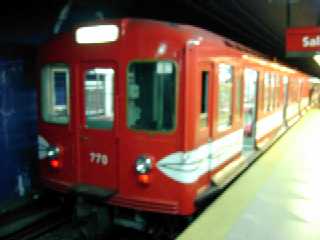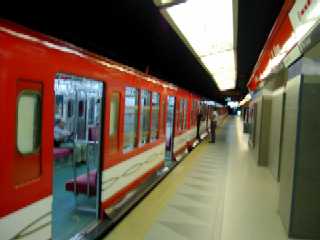The subway of Buenos Aires is called Subte and operated by the organaization 'Metrovías'(vía means rail). This organaization doesn't service buses. There are 5 lines named A to E.
If you want to see the route map, see a route reference page in the official site or page of Buenos Aires in Metro Planet. It is said that the line H, you can find in the Metro Planet's map, will open in this year but we couldn't find even a trace of it. Many cities have subway maps drawn on paper, however, in Buenos Aires, it seemed there is nothing and we couldn't get it. The routes are: line A from Plaza de Mayo, the city centre, to the suburb, line D and E from the second station of line A that go to suburbs and are in a symmetrical position centering on the line A, line B running parallel with the line A, and line C that is at right angles with other 4 lines and connects 2 suburban railway terminals. The network is very simple. By the way, you'll find it when you see the route map, even a station is a connection of lines it has different names for each line. When building Tokyo subway, inspectors came the city, Mr. B said "the inspectors had learned such a bad habit so Tokyo subway's connection stations have different names for each lines."
We got on all the lines in this city and found that trains never run out of underground. It is true to its name 'Subway'. I think it is a rare case.
The trains that ran on Marunouchi line before run on line B. My biggest purpose of this trip is getting on this train. And trains that came from Higashiyama line, Nagoya subway, runs line C and D. Besides, railways in this nation is left-hand traffic, different from its road traffic. But even it is a railway, Premetro, it runs on roads, is right-hand traffic.
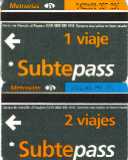 |
| Subway ticket, the above is an 1 time ticket and the below is a 2 times ticket. Enlarge |
The fare is 70 centavo per 1 ride. (1 peso is equal to 100 centavos.) The ticket counter is manned and there are no vending machines. When you tell, for example, "5 time" to the staff, (s)he gives you 5 tickets(Subtepass). If you want to speak strictly, You can say "Una viaje, por favor. ('viaje' means trip and 'por favor' is please in English)" but people in this city don't say such a irritating thing and tell only the number. The ticket is valid forever so you can buy numbers of tickets if you don't have any plan to ride the train immediately.
The size of the ticket is about to visiting card. It has a hole, however, this is not made when I passed the ticket gate but existed yet when I purchase it. I wonder what is the purpose of this hole. There are also a 2 times ticket, 5 times, 30 times, etc. but they have no discount. Why these ticket can exist? The staffs may also think so, they never gave us except 1 time tickets even if we told 5 times. But I accidentally get the 2 times ticket on the road so I show it.
The ticket gate is turnstyle. When you insert a ticket, the pilot lamp turns red. It may mean that it can't accept more ticket but I had thought it means that some error occured. After the processing the ticket comes out and you can go in. It is flat rate so you don't need the ticket now, but the ticket comes back from the gate even it is 1 time ticket. So people throw away tickets and stations and roads become dirty. When you passes the turnstyle, the machine prints day/month/year, time, line, station, left times on the reverse side of the ticket. the image on the right is the reverse side of the 2 times ticket.
When you passes the turnstyle, the machine prints day/month/year, time, line, station, left times on the reverse side of the ticket. the image on the right is the reverse side of the 2 times ticket.
Now, I'll show subway trains. when I take a photograph at underground without a flashlight the shutter speed becomes slow so the photos are out of focus... First, I show you 'Marunouchi line'. It seems that all cars of line B are ex-Marunouchi line car. There are 6-coach train so it is completely the same to it was in Marunouchi line.
These photos were taken at Leandro N. Alem station, the first station of downtown side of line B. The direction display shows this station. Curiously, all trains I saw show this station independently of the trains' direction. Maybe is it broken? Look the number of the car. The letters' style is different from what they were in TRTA, the New York subway style letters. They bother to rewrited numbers. I think the cars' numbers haven't been changed. Steps are attached on the side lower edge of the car.
By the way, this station has a escalator from the platform to upstairs and once you get on it you directly go out of the ticket gates without passing gates.
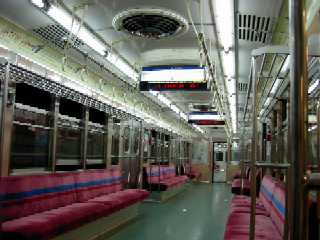 |
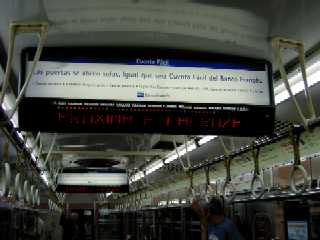 |
| Inside of type 500 Enlarge |
Information display lower display shows "PROXIMA F.LACROZE" Enlarge |
There are few changes inside the car. The only change is the information displays on the ceiling. 2 machines are attached per a car, between doors. Some of other lines' cars have 4 doors on one side but also have only 2 displays. The above of this machine is an advertisement, middle is a route map and lamps from the departure station to the present position are lighting, and the bottom is a character display and shows next stations and transfer informations. 'Next' is 'Próxima', 'transfer' is 'Combinación'. Some cars have more talented machines and they display directions of exits. 'Dirección' '<---Salida---', they display. Such machines can be installed so maybe Metrovías is very rich.
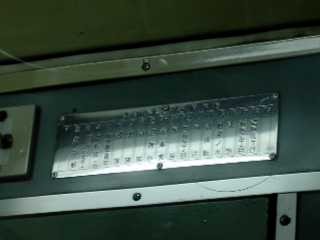 |
| Numbers of direction displays are not changed Enlarge |
A window in the corner was coverd by newspaper but I don't know why.
The photo on the left is a crew's cabin looked into from the passenger cabin. I found there was a list of Marunouchi line's direction displays. Well, it is no necessary to remove it because passengers rarely look into the cabin.
By the way, the display 'Honancho' doesn't exist. I had used Honancho station while I was a junior high school student so I had wanted trains to run directly to Honancho from the main line. The old display of white background had 'Honancho' but the last style of dark blue background didn't have it. Although some cars used the display 'Honancho <--> Nakano-sakaue'.
There was another Japanese sign 'Crew's cabin' on the windows.
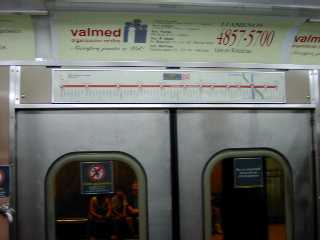 |
| Route map I don't prepare big picture because you can't read letters even enlarged. |
The left is the route map above the door. There are all names of streets and avenues that are on this line or the line crosses. But you can't read the names in this picture because this is out of focus, sorry...
The suburban terminal of line B, Federico Lacroze station is also the terminal of Urquiza Railway that goes to more surburn area. Line B's station is located underground and Urquiza Railway's great terminal is on the ground. They are both Metrovías's railways but Urquiza Railway is Metrovías's only railway of suburban railways in Buenos Aires. Although trains don't run through these lines, the rail connects 2 lines. See the map below to see how the rails are connected each other. We found a organization of Marunouchi line's trains at Urquiza Railway's station. The photos are below.
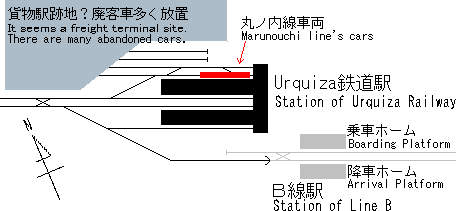 |
| Rail map of Federico Lacroze station |
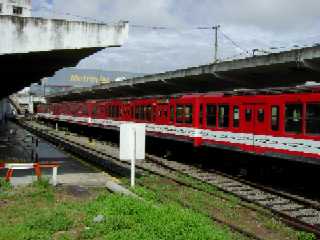 |
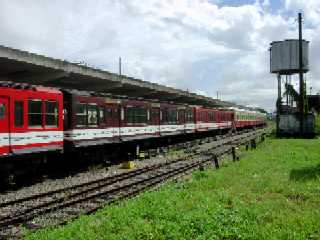 |
| The only 'Marunouchi line' I could see on the ground Enlarge |
The train in the back is Urquiza Railway's Enlarge |
These 2 photos were taken from the same point and are each side of the train. 1 car is black... Why could it become such an appearance? By the way, all cars except head cars are type 900. While they were in Marunouchi line, type 900s are located as 2nd car and 5th car so this organaization was not seen in Japan. I found that the letters of the car number signs are: 2 and 5 are original NY style and 3 and 4 are normal gothic. I think they don't change the sign if the car's position in the 6 cars was not changed.
I think that the carbarn is located near the station because there was a junction at the downtown side of the station but we didn't search well. Even I don't know it is on the ground or underground.

 When you passes the turnstyle, the machine prints day/month/year, time, line, station, left times on the reverse side of the ticket. the image on the right is the reverse side of the 2 times ticket.
When you passes the turnstyle, the machine prints day/month/year, time, line, station, left times on the reverse side of the ticket. the image on the right is the reverse side of the 2 times ticket.
